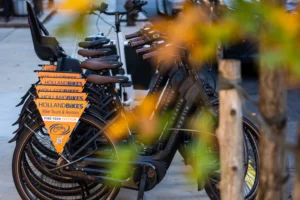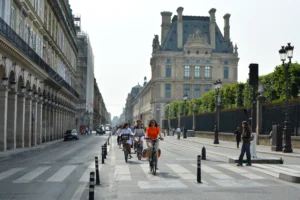Cycling in NYC requires knowing cycling rules NYC and regulations. This guide covers everything you need to know to ride safely and legally in New York City.
Quick Facts
- Cyclists in NYC have the same rights and responsibilities as car drivers, including obeying all traffic laws and yielding to pedestrians.
- All bikes must have safety gear: working brake, lights for night riding, and a bell or audible device.
- E-bikes must follow specific regulations, including power limits and age requirements.
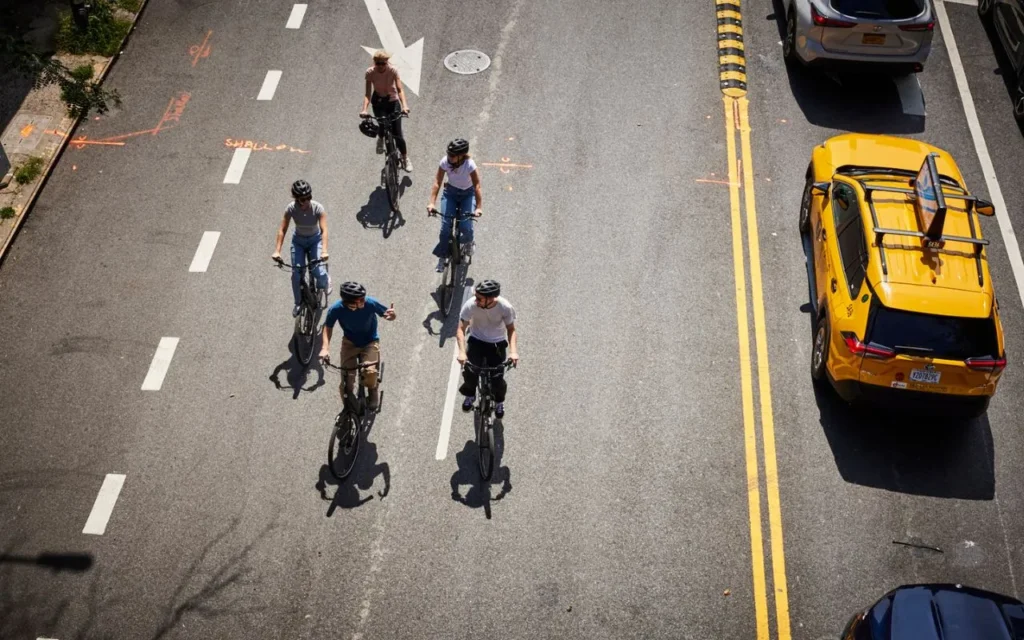
Cyclist Rights and Responsibilities in New York City
Bicyclists in New York City have equal rights and are subject to the same rules as car drivers. So, bike riders must follow all traffic laws, including coming to a full stop at stop signs and obeying traffic signals like any other driver. When leaving private property or approaching busy intersections, cyclists must come to a full stop to ensure everyone’s safety. Cyclists must yield to pedestrians – especially in crosswalks – to help keep pedestrian traffic flowing.
As you ride your bike around New York City, be aware that there is no biking on expressways, highways and high-speed interstate roads unless otherwise indicated by signage. These restrictions are to protect bike riders from high-speed traffic and to ensure coexistence between bike riders and drivers on shared roads.
What is a Bike in NYC
In New York City, the definition of a bike includes any two- or three-wheeled device powered by human, which can also have pedal-assist up to 750 watts. This includes classic pedal bikes and electric bikes, so every type of bike ridden in the city follows the same cycling laws. For a full list of regulations, visit the NYC DOT Bicycle Laws
Equal Road Rights for Cyclists
Cyclists in New York City have the same legal status on public streets as car drivers, which means they must follow all traffic signals and signs. Drivers must recognize cyclists’ rights, especially in bike lanes, by not impeding their safe passage or occupying the lane unless necessary like pulling into a driveway or bypassing roadblocks.Keeping bike lanes open and clear is crucial for safety. So, vehicles must not stop, idle or park in these designated areas so cyclists can use them without hindrance.
By promoting this reciprocity between drivers and bikers we can reduce hazards on the roads and make it a safer place for everyone.
Required Bike Equipment and Safety Gear
To increase road safety, every bike in New York City must be equipped with certain equipment by law. This mandatory gear includes a working brake system that can make the tires skid on dry pavement, reflective materials or reflectors attached to each wheel’s spokes and additional reflective devices to increase visibility at night. These precautions are to make cyclists visible to motor vehicles and pedestrians alike and minimize the chances of accidents and make cycling safer.
Cyclists must follow additional regulations for personal protective equipment as we will outline in later sections. Cyclists must wear an approved helmet when riding their bike. They must also use adequate lighting and other reflective devices for better visibility on the roads. Required is an audible signaling device like a bell to alert others of their presence.
Bike Helmet Requirements
In the state of New York, there is a law requiring certain age groups to wear bike helmets. All children under 14 are required by law to wear safety-certified helmets when they ride bikes. This law also applies in some NYC neighborhoods. Those under 18 who ride electric bikes must wear protective headgear too. Those under 14 who don’t follow these helmet laws can be fined up to $50.
Even if you’re not required by law to wear a helmet while cycling, it’s strongly advised for all riders. Wearing a helmet that fits correctly can greatly reduce your chances of head injury in an accident and make bike riding much safer. Learn more about New York’s helmet laws for cyclists of all ages.
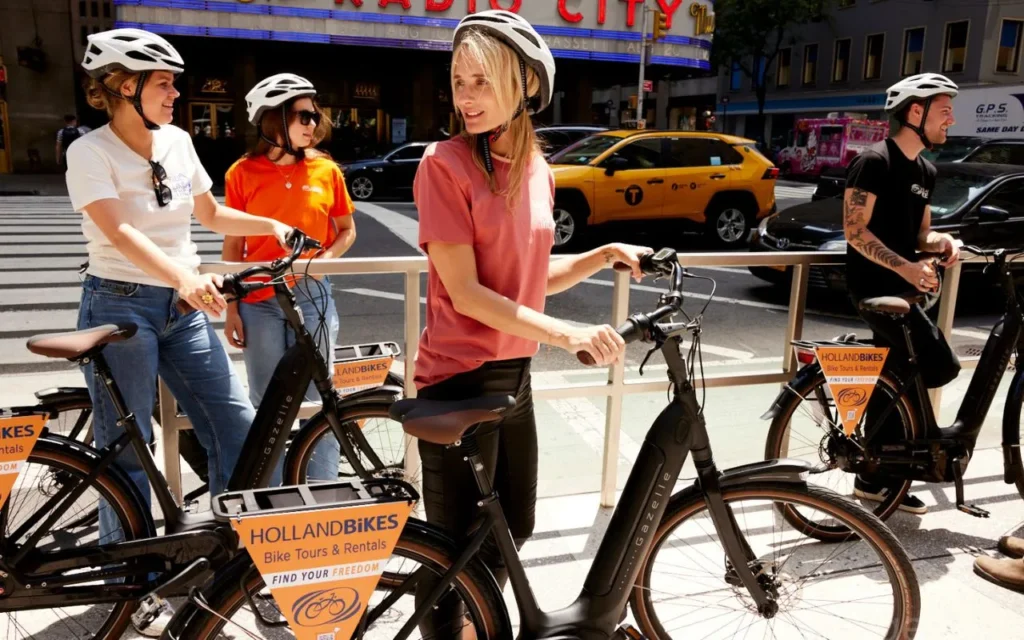
Lighting and Reflective Devices
When riding at night in New York City, it’s required by law for cyclists to have a white light on the front that can be seen 500 feet away and a red or amber light at the back that can be seen 300 feet. This applies from sunset to sunrise.Cyclists are encouraged to wear reflective clothing during night rides as this increases their visibility to drivers and walkers, which is key to their safety.
Bell or Audible Device
In New York City, all bicycles must have a bell or equivalent sound-making device that can be heard 100 feet away. This alerting device must be attached in such a way that the cyclist can easily use it. Note that sirens and whistles are not allowed as substitutes. Having a working bell is safety enhancing as it allows riders to signal their presence to pedestrians and other vehicles.
E-bike Rules in NYC
With the rise of e-bikes in New York City, there are rules in place for their safe use. To protect pedestrians and maintain order on the sidewalks, e-bikes must not exceed 750 watts of motor power and are forbidden from being ridden on walkways. By enforcing these measures, the city is controlling speed and behavior of e-bike riders so they can coexist with other modes of traffic.
Later sections will cover how e-bikes are categorized and what age and licensing requirements apply to individuals who want to ride them.
E-bike Classification
In New York, e-bikes are classified into three types—Class 1, Class 2 and Class 3 which differ in speed and features. Take class 3 e-bikes for example. They can be ridden in bike lanes and regular traffic lanes but must not exceed 25 MPH.
Knowing the classification of their e-bike allows cyclists to follow the rules that apply to their type of bike and be in compliance with the law.
Age and Licensing Requirements
To legally and safely ride an e-bike in New York, you must be at least 16 years old. As of now, there is no need for a license to ride an e-bike but you must comply with the age requirement.
Knowing the classification of their e-bike allows cyclists to follow the rules that apply to their type of bike and be in compliance with the law.
Riding Rules for Cyclists in NYC
Cyclists on bicycles follow the same traffic rules as motor vehicles. This means:
- Stopping at stop signs and red lights
- Signaling intended movements with hand gestures* Pay attention to the road and not text or wear headphones and follow street signs.
Following these rules is key to cycling safely and peacefully with other vehicles according to traffic law.
In this section we will cover bike lanes, overtaking and riding arrangements. Discover how NYC is improving road safety with Vision Zero.
Riding in Bike Lanes
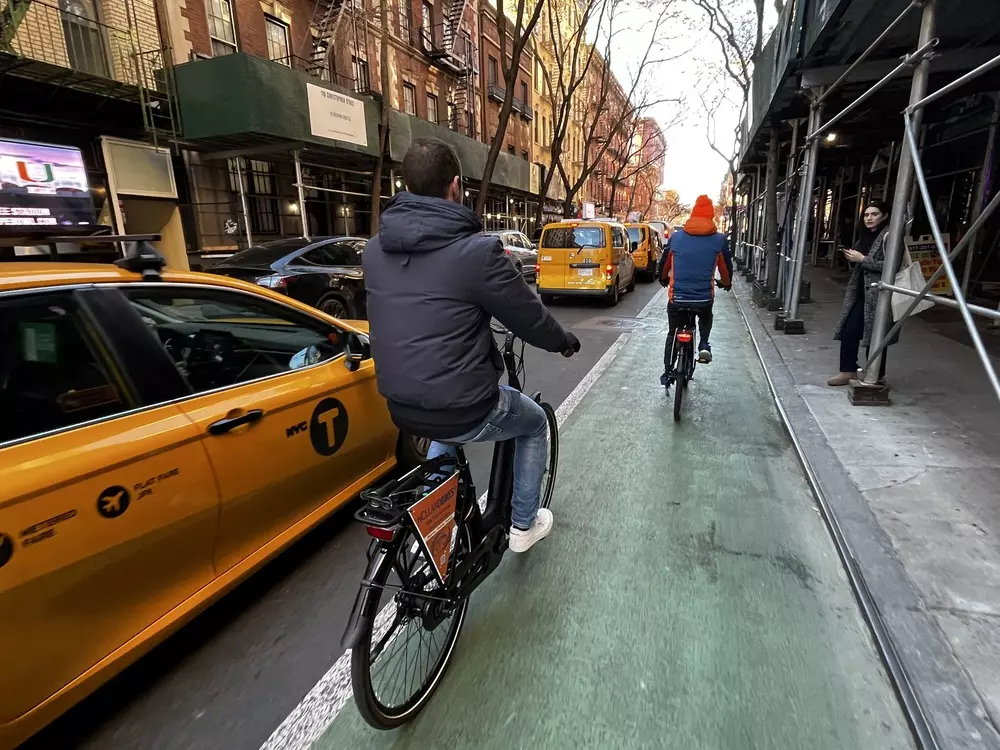
Bike lanes are for bicycles only and must remain clear of other vehicles. Bike lanes permit e-bikes too but cyclists must not ride on sidewalks to avoid fines or even bike confiscation. These rules create a safer and more organized environment in the city’s bike lanes. Plan your route with the official NYC bike lane map.
Passing and Being Passed Safely
In New York, the safe passing law states that when passingcyclists, drivers must pass on the left and maintain a safe gap to minimize the risk of collision. Drivers must be cautious during this maneuver by giving enough space and not making sudden movements that can put the cyclist at risk.
Single File and Two Abreast Riding
When the road is congested or the roadway is narrow, cyclists should ride in single file for everyone’s safety. They can ride side by side or two abreast when traffic is light and space allows but single file is crucial in denser traffic.
Commercial Cycling Rules
In the city that never sleeps, New York City, there are specific rules for commercial bicycles such as delivery bikes. These rules are for safety and accountability on the roads. They include mandatory identification markers and safety gear to increase visibility and protection for those who cycle for commercial purposes.
Later sections will go into details of these requirements. This includes the safe passing laws that apply to cyclists involved in commercial activities in New York City.
Identification and Equipment for Delivery Bikes
To be legal in NYC, commercial delivery bikes must have visible identification and required safety gear. This mandates that cyclists who make deliveries can be seen and held accountable for their actions on the city’s roads.
Safe Passing and Idaho Stop LawIn New York City, cyclists are currently required to follow regular stop signs and traffic signal rules because the Idaho stop law—which allows bicyclists to treat stop signs as yield signs and red lights as stop signs—has not been implemented yet.
As part of ongoing efforts to improve cyclist safety in the city, lawmakers are discussing possibly enacting this law.
Fines for Violating Cycling Laws
Cyclists in New York City can be fined for various violations just like motor vehicle infractions. Fines range from $25 to $250 depending on the offense and repeated violations can lead to higher penalties. Knowing and following cycling laws helps avoid fines and safe riding.
Let’s cover common violations, fines and serious offenses with legal consequences.
Common Violations and Fines
Riding through red lights, cycling without lights after dusk and using sidewalks for bike riding are common violations of cycling rules. These can result in fines and legal repercussions, so cyclists must follow traffic rules and signs.
In cases of serious or repeated violations, offenders may face stiffer penalties or criminal charges.
Serious Offenses and Legal Consequences
Violations of cycling rules, especially when they harm others, can result in serious legal consequences like criminal charges and heavy fines. This emphasizes the need for cyclists to ride responsibly and safely. Injured while violating rules can intensify the penalties for a cyclist, so complying with every traffic law and safety protocol is crucial during your ride.
In cases of serious or repeated violations, offenders may face stiffer penalties or criminal charges.
Cycling Safety Tips
Choose a cycling route that fits your comfort level and includes bike lanes and paths without cars is a basic guide for biker safety. Check your bike before heading out, make sure the seat height is correct, tires are inflated and brakes are working. Ride with traffic and focus to avoid distractions and you’ll be more secure on the road. Knowing common road hazards like potholes or debris can help cyclists prevent accidents.
Next, we will offer specific tips on how to stay visible and how to handle situations when visibility is compromised.
In cases of serious or repeated violations, offenders may face stiffer penalties or criminal charges.
Staying Visible and Alert
Cyclist safety on the road requires visibility. Cyclists in NYC are required to have front white lights and rear red or amber lights on their bikes especially during nighttime riding. To be more visible to drivers and pedestrians, cyclists should wear bright clothes and reflective gear.
When visibility is poor, cyclists should slow down, use their lights properly and not make sudden movements as these can add safety.
Navigating Poor Visibility Conditions
Riding a bike with little light or visibility is dangerous and extra precautions are necessary. By using lights and reflective gear, cyclists increase their chances of being seen by others on the road and reduces the chance of accidents.
Conclusion
Cycling in New York City requires a understanding of bike laws and regulations. Cyclists must know their duties and rights as well as follow safety gear requirements to ensure every ride is safe for all. Being knowledgeable and equipped allows those on bikes to enjoy the freedom of cycling while also creating a peaceful and safe city. Remember safety is first. Following these rules will help you ride your bike safely in NYC.
Need a bike? Check out our bike rentals in NYC for a smooth ride around the city.
- Cyclists in NYC have the same rights and responsibilities as car drivers, including obeying all traffic laws and yielding to pedestrians.
- All bikes must be equipped with basic safety gear, including a working brake, lights for night riding and a bell or audible device.
- Electric bikes in NYC must follow specific regulations, including power limits and age requirements, and cyclists must follow safe riding practices and traffic laws.
FAQs
Do cyclists have to yield to pedestrians in NYC?
Yes, cyclists must yield to pedestrians in NYC as pedestrians always have the right of way.
Failure to do so will result in fines.
Do bicycles have to stop at red lights in NYC?
Yes, bicycles must stop at red lights and stop signs in NYC as it is against the law to run them. Compliance with traffic signals is for everyone’s safety.
Is it illegal to ride a bike without a helmet in NYC?
It is illegal to ride a bike without a helmet if you are under 14 in NYC and commercial cyclists are also required to wear helmets. But there are no state laws requiring helmet use for adults.
What is required for bicycles in NYC?
In NYC, every bike must have functional brakes, reflective tires or spokes and a bell or audible device that can be heard from at least 100 feet away.
These are for safety and visibility.
Do helmets have to be worn by all cyclists in NYC?
Helmets are required for children under 14 and for individuals under 18 using e-bikes in NYC.
But it’s recommended for all cyclists to wear a properly fitted helmet.

